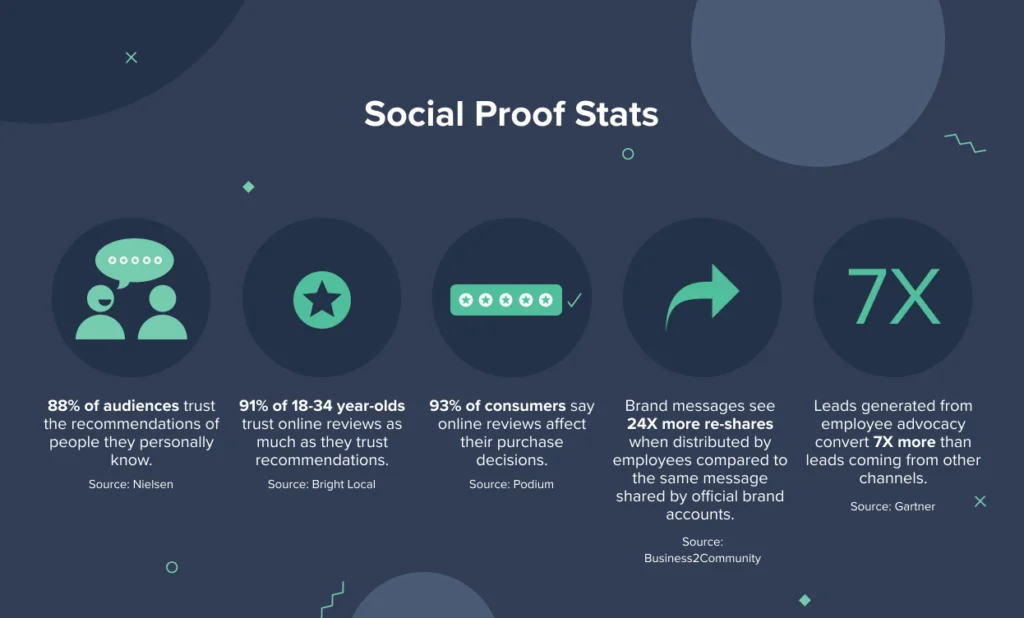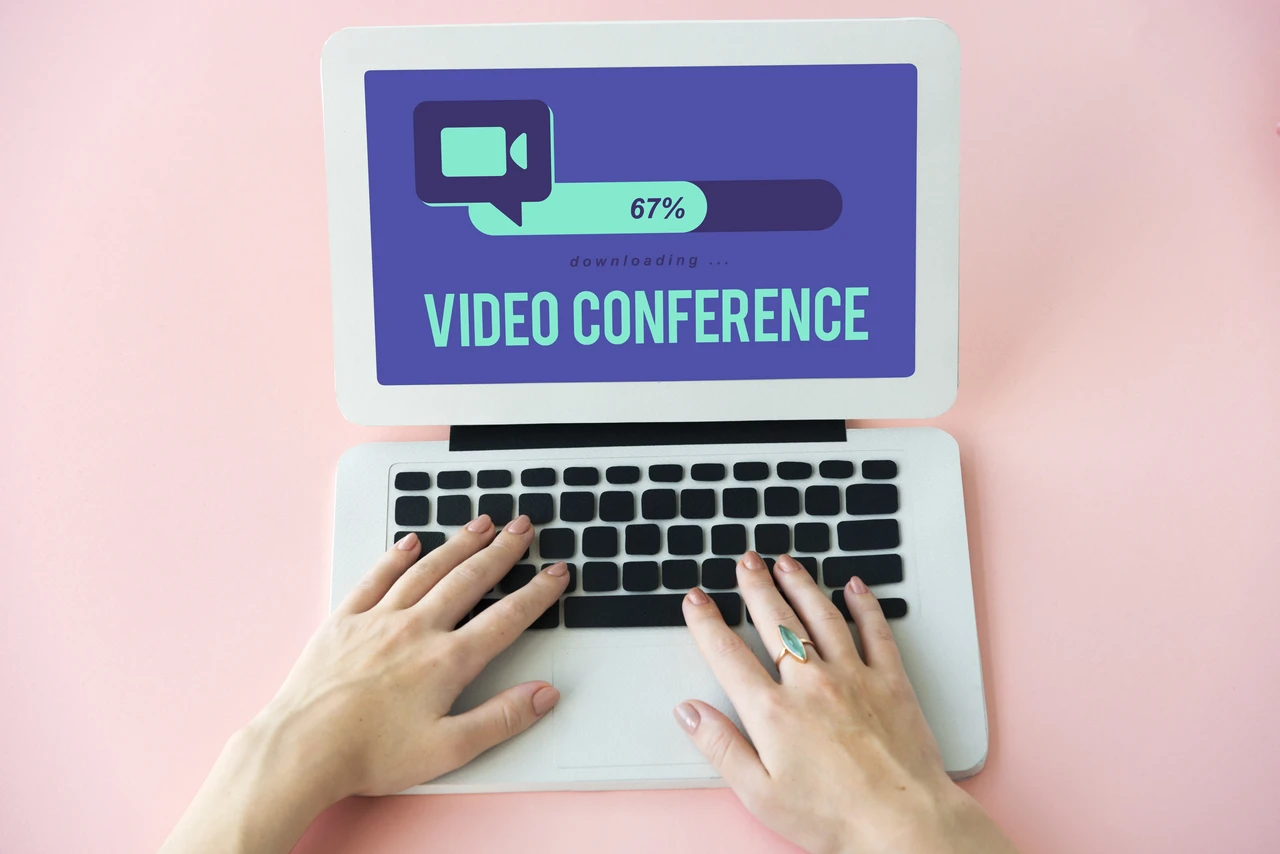Listen to article
In an era overwhelmed with choices, how do you make your brand stand out? The answer lies in trust. And what better way to earn trust than through social proof?
Social proof marketing leverages the influence of others to sway potential customers. It’s about showing, not just telling, why your product or service is the right choice. Think of it as the modern-day word-of-mouth, amplified by the internet.
But does social proof marketing still work in today’s ever-evolving digital landscape? Is it still effective at influencing consumer behavior and driving conversions?
In this article, we will explore the effectiveness of social proof, supported by the latest industry statistics, and delve into various content formats for building brand credibility and driving sales.
How Content Marketing and Blogging Build Authority and Trust
For B2B businesses, demonstrating authority in your niche is no longer optional—it’s essential. As decision-makers weigh their options, they’re looking for more than just a product or service; they’re seeking expertise, credibility, and proof that your business understands their challenges. High-value content and blogs serve as cornerstone strategies to build this credibility, offering not only insights but also a steady channel for lead generation and relationship-building. Here’s what the data reveals:
- B2B companies publishing blogs consistently generate 67% more leads per month than those without a regular blogging schedule. Source
- 52% of B2B marketers rank blogging as the most critical tactic for achieving success in their content marketing strategies. Source
- 59% of B2B marketers identify blogs as their most valuable marketing channel. Source
- 58% of B2B marketers report that content marketing has directly increased their sales and revenue over the last year. Source
- 80% of business professionals rely on written content when researching potential vendors. Source
These statistics paint a clear picture: consistent blogging and content marketing are more than just lead generation tools—they’re pathways to long-term trust and influence in your industry.
Key Takeaway
The numbers don’t lie—blogs and content marketing aren’t just “extras” for B2B success; they’re fundamental ingredients. By adopting a content-first mindset, businesses can not only improve their visibility but also create lasting impressions that resonate with their audience. When your content directly addresses the questions and challenges your prospects face, you’re not just offering solutions—you’re proving your authority. And with competition for attention continuing to rise, those who master valuable, targeted content will hold a key advantage.
Pro Tip:
To maximize the impact of your blogging efforts, focus on quality over quantity. Conduct audience research to identify the specific challenges and questions they’re grappling with, then create in-depth, actionable content to address those needs. Incorporate SEO best practices and promote blogs through multiple channels, such as email marketing and social media, to ensure your message reaches the right audience effectively. Businesses exploring broader digital strategies can also consider full-service marketing to integrate blogging with other impactful channels for maximum digital marketing ROI.
High-Impact Content Formats, User-Generated Content, and the Power of Video

Source: PostBeyond
Beyond blogging, certain content formats are particularly effective in conveying social proof and resonating with B2B audiences. User-generated content (UGC) and video content continue to be powerful tools for brands looking to boost engagement and build trust. Consumers are more likely to engage with content created by their peers, and video’s engaging nature makes it ideal for showcasing social proof. Here’s a look at the statistics:
- Ebooks and white papers are used by 50% of B2B marketers, 47% use case studies, and 41% use social media posts for content marketing purposes. Source
- Brands that integrate user-generated content into their marketing campaigns can see engagement increase by approximately 25%. Source
- A significant 60% of users have indicated they would be willing to create content for a brand if they were offered an incentive. Source
- User-generated videos on platforms like YouTube often outperform brand-produced content, receiving up to ten times more views. Source
- An impressive 86% of businesses are now utilizing video as a marketing tool. Source
- 94% of video marketers recognize video as a crucial component of their overall marketing strategy. Source
- A significant 69% of people prefer to learn about new products or services through short videos. Source
- A large number of consumers, 88%, express a desire to see even more video content from brands. Source
- Short-form videos, those under 90 seconds, maintain the attention of 50% of viewers, making them ideal for ads and social media content. Source
Key Takeaway
These statistics highlight the effectiveness of various content formats, the importance of user-generated content, and the growing influence of video in maximizing the reach and impact of social proof marketing. By leveraging high-value content, incentivizing users to create content, and focusing on engaging video strategies, B2B marketers can enhance their brand credibility and drive better results.
Pro Tip:
Invest in a mix of content formats to cater to different audience preferences, consider launching a contest or offering rewards for user-generated content to encourage participation and boost engagement, and ensure your video content is high-quality and tells a compelling story. For those looking to expand their strategies further, exploring a strong B2B website strategy can help align content efforts with broader marketing goals and improve overall performance.
Video and Social Proof for Higher Conversions
In a world where decision-makers are inundated with content, video has emerged as a standout medium for cutting through the noise and building trust. Beyond captivating visuals, video content taps into the persuasive power of social proof—whether through authentic testimonials, product demos, or explainer videos that address specific buyer pain points. For B2B companies, where purchases often involve extensive research and multiple stakeholders, video offers a direct and compelling way to influence decisions.
- Approximately 87% of marketers have reported a direct increase in sales through the use of video. Source
- Around 82% of consumers have indicated that video was a convincing factor in their purchase decisions. Source
- 64% of consumers are more likely to buy a product after viewing branded videos on social media platforms. Source
- 88% of B2B buyers have watched video content to learn about products or services in the past three months. Source
- 14% of B2B buyers consider video the most valuable content type during the decision-making process. Source
- Testimonial videos and explainer videos are among the most popular types of video content used by B2B companies. Source
- 90% of marketers using short-form video plan to maintain or increase their investment, recognizing its high ROI. Source
Key Takeaway
It’s not just about creating videos; it’s about creating the right kinds of videos. Showcasing authentic testimonials or producing in-depth explainer videos doesn’t just highlight your product or service—it demonstrates credibility, empathy for the buyer’s challenges, and a clear solution. Buyers, especially in the B2B space, are looking for evidence of success and trustworthiness, and video provides a dynamic way to deliver this proof.
Pro Tip:
Want to maximize the impact of your videos? Showcase your satisfied customers through interviews or case studies and then distribute those videos across high-traffic platforms like LinkedIn or industry-specific newsletters. Pair them with concise written content to provide additional context and make sure to include strong CTAs that guide viewers to the next step in your sales funnel.
How Online Communities and Paid Strategies Drive Influence
The digital landscape is driven by conversations, reviews, and the collective experiences shared within online communities. Platforms like Reddit and YouTube have become central hubs for consumer decision-making, where authentic recommendations often carry more weight than traditional advertising. Pairing these community-driven insights with targeted paid strategies can amplify your brand’s visibility while also nurturing trust through social proof. Let’s unpack some compelling statistics that illustrate this dynamic.
- YouTube leads as the top social platform influencing purchase decisions. Source
- A staggering 87% of YouTube users report that the platform helps them make quicker purchase decisions. Source
- SEM/PPC is the backbone of many B2B marketing strategies, with 61% of marketers citing it as their most effective paid channel. Social media advertising follows at 49%, with sponsorships (48%) and digital display advertising (35%) rounding out the list. Source
- Paid ads are efficient: 75% of people agree that they simplify the search for products and services. Source
- However, 50% of users struggle to differentiate between paid and organic search results. Source
- Visitors arriving via PPC ads are 50% more likely to make a purchase compared to those who discover brands through organic search. Source
- For younger demographics like Gen Z, user-generated content (UGC) is a powerful trust-builder, leveraging peer recommendations to establish credibility. Source
Key Takeaway
The data underscores the importance of meeting consumers where they are, whether it’s engaging in meaningful conversations on platforms like Reddit or leveraging the power of visual discovery on YouTube. But the real secret lies in combining authenticity with strategic paid efforts. Social proof works best when trust has already been established, and amplifying that trust through smart targeting ensures your message resonates with the right audience. From user-generated content to tailored paid ads, every touchpoint should inspire confidence and make purchasing seamless.
Pro Tip:
Use your paid campaigns to highlight authentic social proof—customer reviews, UGC, and ratings can serve as compelling selling points within your ads and landing pages. Transparency and authenticity go hand in hand, so make this a cornerstone of your paid and community-driven marketing strategies.
Conclusion
Social proof marketing remains an indispensable strategy for businesses aiming to build trust, engage their audience, and drive measurable results. The statistics shared throughout this article paint a clear picture: from authoritative blogs to user-generated content, and from high-impact videos to community-driven recommendations, the power of social proof lies in its ability to influence decisions at every stage of the buyer’s journey. Whether it’s the 87% of marketers seeing increased sales through video or the 67% boost in leads from consistent blogging, the data underscores the value of leveraging authentic, credible, and relevant content formats.
But the real magic happens when businesses strategically align these tactics with their audience’s expectations. By diversifying content formats, integrating video testimonials, incentivizing UGC, and tapping into the influence of social platforms, you can amplify your brand’s credibility and reach. Partnering with a professional social media management service can elevate this approach even further—ensuring your content is strategically distributed, performance is continuously optimized, and your brand’s voice stays consistent across every platform.
Ready to boost your traffic and grow your website? Your customers are looking for you, and our SEO services can help you be found across search engines. Reach out today, and let’s take your social proof marketing to the next level!
About Social Proof in Marketing: Does It Still Work?
This guide was written by the Scopic Studios team and reviewed by Araksya Hakobjanyan, SEO Lead at Scopic Studios.
Scopic Studios delivers exceptional and engaging content rooted in our expertise across marketing and creative services. Our team of talented writers and digital experts excel in transforming intricate concepts into captivating narratives tailored for diverse industries. We’re passionate about crafting content that not only resonates but also drives value across all digital platforms.
Note: This blog’s feature image is sourced from Freepik.

































































































































































































































































